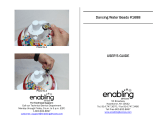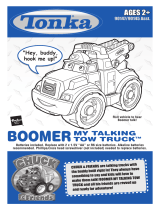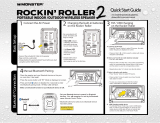Hasbro Rockin' Radio 06095 User manual
- Category
- Toy vehicles
- Type
- User manual
This manual is also suitable for

OVER 6 months
06095
Thank you for choosing this PLAYSKOOL brand toy!
Includes 3 x 1.5V "AA"/R6 batteries. Alkaline
batteries recommended. Phillips/cross head
screwdriver (not included) required for battery
installation.
Rockin’ Radio
®
Rockin’ Radio

TO PLAY
NOTE: Toy is shipped in "DEMO" mode.
Move switch on unit from "DEMO" to "PLAY"
for full use at home.
Toddlers will love the upbeat, happy songs
and fun activities of the ROCKIN’ RADIO
toy! The convenient carry handle lets your
toddler take the toy everywhere!
• Each time you press the button, a nursery song plays! Hear 8 rockin’
nursery rhyme songs in all!
• Spin the colorful roller!
• Push the antenna down or tap the music note to make the note
"dance" and beads rattle!
• Rock the radio back and forth with a gentle push!
• Turn the clicking dial to reveal
colorful music-note pals!
PPuusshh
TTuurrnn
PPrreessss
SSppiinn
TTaapp
P
L
A
Y
O
F
F
D
E
M
O
DDEEMMOO
PPLLAAYY OOFFFF

TO REPLACE BATTERIES
Using Phillips/cross head
screwdriver, loosen screw in
battery compartment cover
(screw stays attached to
cover). Remove cover. Remove
and discard old batteries.
Replace with 3 fresh "AA"/LR6
(1.5V) alkaline batteries. Replace
cover and tighten screw.
CAUTION: TO AVOID BATTERY LEAKAGE
1) Be sure to insert the batteries correctly and always follow the toy
and battery manufacturers' instructions;
2) Do not mix old and new batteries or alkaline, standard (carbon-zinc)
or rechargeable (nickel-cadmium) batteries;
3) Always remove weak or dead batteries from the product.
IMPORTANT: BATTERY INFORMATION
Please retain this information for future reference.
Batteries should be replaced by an adult.
CAUTION:
1. Always follow the instructions carefully. Use only batteries specified and
be sure to insert them correctly by matching the + and – polarity markings.
2. Do not mix old batteries and new batteries or standard (carbon-zinc) with
alkaline batteries.
3. Remove exhausted or dead batteries from the product.
4. Remove batteries if product is not to be played with for a long time.
5. Do not short circuit the supply terminals.
6. Should this product cause, or be affected by, local electrical interference,
move it away from other electrical equipment. Reset (switching off and
back on again or removing and re-inserting batteries) if necessary.
7. RECHARGEABLE BATTERIES: Do not mix these with any other types of
battery. Always remove from the product before recharging. Recharge
batteries under adult supervision. DO NOT RECHARGE OTHER TYPES
OF BATTERIES.

Responds to “no” and changes in tone of voice
YES NO
Talk to your doctor if you answer NO to any of these questions:
Call the National Campaign for Hearing Health at 1.800.535.3323 or visit
www.hearinghealth.net for more information.
Based on NIDCD/NIH infant hearing checklist.
Birth to 3 Months
Reacts to loud sounds
Is soothed by your voice
Turns head to you when you speak
Seems to know your voice and quiets down if crying
YES NO
3 to 6 Months
Looks upward or turns toward a new sound
Enjoys rattles and other toys that make sounds
Becomes scared by a loud voice
Your Baby's Hearing Checklist
Provided by
National Campaign for Hearing Health
1050 17th Street NW, Suite 701
Washington, DC 20036
The National Campaign for Hearing Health is sponsored by the Deafness Research
Foundation. It is a public outreach, professional education and government relations
initiative whose goal is to educate the public about hearing health.
At Playskool, we want to do all we can to help ensure that children thrive
developmentally. That's why we have partnered with the National Campaign
for Hearing Health to provide you with this Hearing Checklist for babies.
© 2003 Hasbro. All Rights Reserved.
® denotes Reg. U.S. Pat. & TM Office.
06095 P/N 6193380200
PLAYSKOOL.COM
FOR NEW PRODUCTS AND OFFERS
PLAYSKOOL.COM
FOR NEW PRODUCTS AND OFFERS
Questions? Call: 1-800-PLAYSKL
FCC STATEMENT
This equipment has been tested and found to comply with the limits for a Class B digital device,
pursuant to part 15 of the FCC Rules. These limits are designed to provide reasonable
protection against harmful interference in a residential installation. This equipment generates,
uses and can radiate radio frequency energy, and, if not installed and used in accordance with
the instructions, may cause harmful interference to radio communications. However, there is no
guarantee that interference will not occur in a particular installation. If this equipment does
cause harmful interference to radio or television reception, which can be determined by turning
the equipment off and on, the user is encouraged to try to correct the interference by one or
more of the following measures:
- Reorient or relocate the receiving antenna.
- Increase the separation between the equipment and the receiver.
- Consult the dealer or an experienced radio/TV technician for help.
-
 1
1
-
 2
2
-
 3
3
-
 4
4
Hasbro Rockin' Radio 06095 User manual
- Category
- Toy vehicles
- Type
- User manual
- This manual is also suitable for
Ask a question and I''ll find the answer in the document
Finding information in a document is now easier with AI
Related papers
-
Hasbro Light 'N Play Key Ring User manual
-
Hasbro Talking Picture Phone Operating instructions
-
Hasbro 6095 User manual
-
Hasbro Thintronix Poster Radio Operating instructions
-
Hasbro Made Operating instructions
-
Hasbro Fun Shakin' Phone User manual
-
Hasbro Rubbadubbers Mighty Talkin' Finbar User manual
-
Hasbro Talking Tubb 31358 User manual
-
Hasbro Workshop: Circular Saw User manual
-
Hasbro Workshop: Circular Saw User manual
Other documents
-
 Tonka CHUCK & FRIENDS GUS MY TALKING GARBAGE TRUCK User manual
Tonka CHUCK & FRIENDS GUS MY TALKING GARBAGE TRUCK User manual
-
Playskool Busy Ball Popper User manual
-
 Enabling Devices 1688 User manual
Enabling Devices 1688 User manual
-
 Tonka CHUCK & FRIENDS GUS MY TALKING GARBAGE TRUCK User manual
Tonka CHUCK & FRIENDS GUS MY TALKING GARBAGE TRUCK User manual
-
Playskool Li'l Glofriends 06564 User manual
-
Playskool Rock*tivity Walk'n Roll Rider 39938 Operating instructions
-
 Monster Power Rockin' Roller 2 Quick start guide
Monster Power Rockin' Roller 2 Quick start guide
-
Playskool Playskool Song Magic Guitar (2007) User manual
-
Playskool Sit n Spin 34676 User manual
-
Playskool Sit n Spin 34676 User manual







